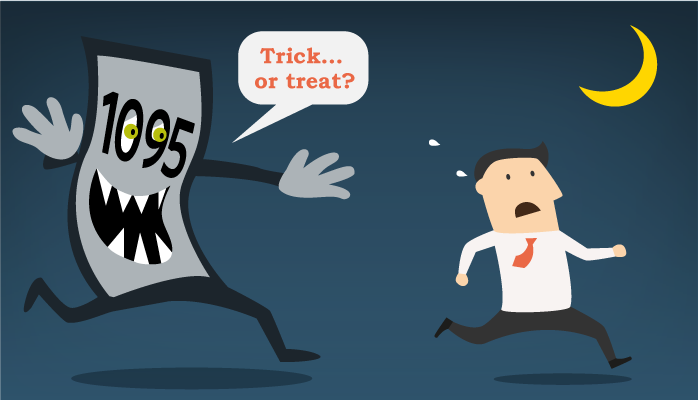
5 ways the 1095 Form is like Halloween

Hot on the heels of annual enrollment, employers’ next benefits communication challenge is just around the corner. In a few months, they’ll need to send employees the 1095 Form, required under the Affordable Care Act as a way for Americans to show proof of health coverage to the IRS.
As we researched the form and its complexities, we quickly realized that mixing ACA and the IRS is more scream-worthy than the creepiest Halloween horror flick. In honor of next week’s haunted holiday, here are five other ways the 1095 Form reminds us of Halloween.
1. It disguises itself in simplicity.
In theory, the 1095 is a simple form. Similar to an employee’s W-2, it lists employee’s personal info, basic company information, a cost breakout of the plan that shows an individual’s health insurance meets ACA requirements, and the folks covered by that plan in 2015. Easy breezy, right? It would be, if only the form weren’t created by the IRS!
The 1095 comes in three versions: A, B and C. The 1095-A goes to Americans who purchased their 2015 health insurance from an exchange. The 1095-B will be distributed by insurance companies on behalf of employers that offer fully insured medical plans, as well as by employers who have fewer than 50 employees. The 1095-C will be distributed by employers that offer self-insured plans and have 50 or more workers.
The multiple versions mean that there are also multiple scenarios for how many forms and how many versions of the 1095 that American households will receive. With that many variations, simplicity goes out the window.
2. It sneaks up on you.
The 1095 should reach employees by January 31, 2016. Assuming you have the administrative side sorted out (which may have already been a nightmare for your team), the communications challenge is sneaking up fast. The holidays will be here before we know it and early January is when you need to:
- Educate managers, and organization leaders about the form and how to respond to employee questions.
- Get online resources ready to help answer employee questions.
- Educating employees about what the form is, when to expect it, what to do with it, and where to go with questions.
3. It puts you in a corn maze of administrative chaos.
Employers that have fully insured and self-insured plans will send employees the 1095-B and 1095-C. Employees—depending on where/if they worked in 2015, and where they were covered—could potentially receive all three versions. Not to mention spouses and adult dependents up to age 26, and employers and their workforces, could all be flailing in forms.
4. It carves up your well-laid communication plans like a jack-o-lantern.
After enrollment season wraps up, benefits communication can focus on helping employees understand how to use their new benefits once the new year begins. Maybe even a specialized communication campaign focused on financial or physical wellness, or both! For employers not proactive and prepared, the 1095 has the potential to suck all the oxygen out of communication plans at the beginning of the 2016.
5. It does have one treat!
So, distributing the 1095 Form isn’t all bad. On the bright side, it offers employers a golden opportunity to sing the praises of their health benefits. Most employers offer Gold- and Platinum-level plans to their workforce—at Bronze-level costs. The 1095 Form highlights those cost/quality differences in a way that makes employers health insurance heroes for their people.
![]() Want to avoid the Halloween horrors of distributing the 1095 Form? Sign up to purchase our 1095-C Toolkit! Specially designed for self-insured employers with 50 or more employees, we offer three packages—all full of turnkey resources that are easy to customize for your audience. Avoid the chaos! Save yourself time—and receive $500 off the package of your choice—when you sign up now.
Want to avoid the Halloween horrors of distributing the 1095 Form? Sign up to purchase our 1095-C Toolkit! Specially designed for self-insured employers with 50 or more employees, we offer three packages—all full of turnkey resources that are easy to customize for your audience. Avoid the chaos! Save yourself time—and receive $500 off the package of your choice—when you sign up now.
Work with Us
We partner with organizations that value their people first. Let’s talk.

Jennifer Benz, SVP Communications Leader, has been on the leading edge of employee benefits for more than 20 years and is an influential voice in the employee benefits industry.
